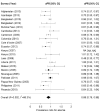Association between anemia and household water source or sanitation in preschool children: the Biomarkers Reflecting Inflammation and Nutritional Determinants of Anemia (BRINDA) project
- PMID: 32743647
- PMCID: PMC7396266
- DOI: 10.1093/ajcn/nqaa148
Association between anemia and household water source or sanitation in preschool children: the Biomarkers Reflecting Inflammation and Nutritional Determinants of Anemia (BRINDA) project
Abstract
Background: The associations between anemia and household water source and sanitation remain unclear.
Objectives: We aimed to assess the associations between anemia and household water source or sanitation in preschool children (PSC; age 6-59 mo) using population-based surveys from the Biomarkers Reflecting Inflammation and Nutritional Determinants of Anemia (BRINDA) project.
Methods: We analyzed national and subnational data from 21 surveys, representing 19 countries (n = 35,963). Observations with hemoglobin (Hb) and ≥1 variable reflecting household water source or sanitation were included. Anemia was defined as an altitude-adjusted Hb concentration <110 g/L. Household water source and sanitation variables were dichotomized as "improved" or "unimproved." Poisson regressions with robust variance estimates were conducted for each survey, adjusting for child sex, age, household socioeconomic status, maternal education, and type of residence.
Results: Access to an improved water source and improved sanitation ranged from 29.9% (Burkina Faso) to 98.4% (Bangladesh, 2012), and from 0.2% (Kenya, 2007) to 97.4% (Philippines), respectively. Prevalence of anemia ranged from 20.1% (Nicaragua) to 83.5% (Bangladesh, 2010). Seven surveys showed negative associations between anemia and improved sanitation. Three surveys showed association between anemia and improved water, with mixed directions. Meta-analyses suggested a protective association between improved household sanitation and anemia [adjusted prevalence ratio (aPR) = 0.88; 95% CI: 0.79, 0.98], and no association between improved household water and anemia (aPR = 1.00; 95% CI: 0.91, 1.10). There was heterogeneity across surveys for sanitation (P < 0.01; I2 = 66.3%) and water (P < 0.01; I2 = 55.8%).
Conclusions: Although improved household sanitation was associated with reduced anemia prevalence in PSC in some surveys, this association was not consistent. Access to an improved water source in general had no association with anemia across surveys. Additional research could help clarify the heterogeneity between these conditions across countries to inform anemia reduction programs.
Keywords: BRINDA; anemia; complex survey; preschool children; sanitation; water.
Copyright © The Author(s) on behalf of the American Society for Nutrition 2020.
Figures



Comment in
-
Anemia and water, sanitation, and hygiene (WASH)-is there really a link?Am J Clin Nutr. 2020 Nov 11;112(5):1145-1146. doi: 10.1093/ajcn/nqaa213. Am J Clin Nutr. 2020. PMID: 32692804 No abstract available.
References
-
- Balarajan Y, Ramakrishnan U, Ozaltin E, Shankar AH, Subramanian SV. Anaemia in low-income and middle-income countries. Lancet. 2011;378(9809):2123–35. - PubMed
-
- Hernandez IL, Alcazar L. The economic impact of anaemia in Peru. Lima: GRADE, Action Against Hunger; 2013.
-
- WHO The global prevalence of anaemia in 2011. Geneva: World Health Organization; 2015.
-
- Global Health Observatory data repository Anaemia in children <5 years. Estimates by WHO region. [Internet] [cited February 14, 2020]. Available from:http://apps.who.int/gho/data/view.main.ANEMIACHILDRENREGv?lang = en.
-
- PopulationPyramid.net Population pyramids of the world from 1950 to 2100. [Internet]. [cited February 14, 2020]. Available from:https://www.populationpyramid.net/world/2016/.
Publication types
MeSH terms
Substances
LinkOut - more resources
Full Text Sources
Medical
Miscellaneous

